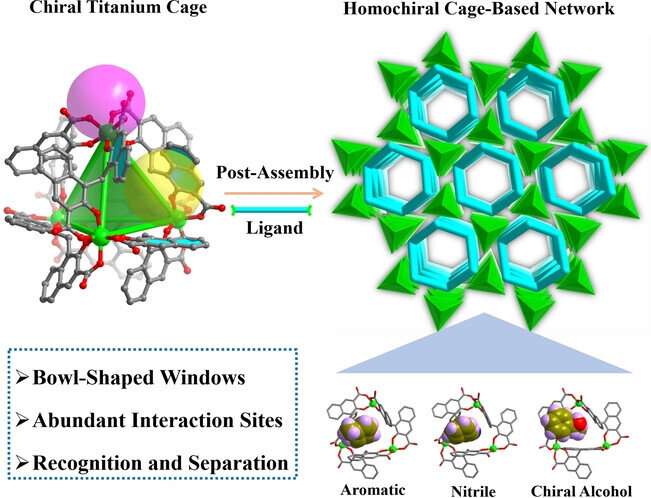Modification of titanium–organic cages for recognition and separation of molecular isomers

Discrete metal–organic cages (MOCs) with unique cavities have attracted considerable research attention. Their accessible hydrophobic inner spaces can absorb and orient guest molecules by means of supermolecular interactions, making them broadly applicable to molecular encapsulation, among other applications.
The nuclear magnetic resonance (NMR) spectroscopy and electrospray ionization mass spectrometry (ESI-MS) analyses are commonly used to investigate the host–guest interactions between the host MOC and adsorbed guest species. However, studying how the host–guest complexes behave at molecular level remains a challenge, because high-quality single crystals of host MOC are required to realize guest exchange and structure analysis using conventional X-ray diffraction methods.
In a study published in Angewandte Chemie International Edition, the research group led by Prof. Zhang Jian from Fujian Institute of Research on the Structure of Matter of the Chinese Academy of Sciences, reported the post-assembly modification of homochiral titanium–organic cages for recognition and separation of molecular isomers.
The researchers extended and fixed the pre-synthesized chiral MOC into a porous framework, improving its crystal stability in the solid state and enabling the study of host guest behavior at the molecular level.
By employing the chiral MOC as a precursor, the researchers synthesized a pair of size-tunable and homochiral Ti4L6 cage-based frameworks polynuclear titanium cage (PTC)-236(Δ and Λ) using a post-assembly reaction. They constructed the three-dimensional microporous framework of PTC-236 by using ΔΔΔΔ- or ΛΛΛΛ-[Ti4L6] cages with triple-stranded left- or right-handed helical Zn-bimb chains (bimb = 4,4′-di(1H-imidazol-1-yl)-1,1′-biphenyl).
The researchers found that PTC-236 was highly stable in air, water, and other solvents, and possessed chiral pore channels in its host framework and rich recognition sites provided by the cage moieties. These characteristics facilitated the study of PTC-236 in host–guest chemistry via single-crystal-to-single-crystal transformation. They utilized PTC-236 for the X-ray diffraction analyses of more than 20 guests, including benzene (PhH) and its derivatives, aromatic/aliphatic nitriles, and aromatic alcohol molecules.
The researchers also revealed that the material exhibited selective recognition and separation ability for spice Cinnamonitrile cis-trans isomers with up to 95% separation. They can clearly observe the host-guest interactions between the titanium cage and captured guests.
This study provides a new strategy for the orderly combination of structurally well-defined MOCs into functional porous frameworks, expands the use of MOCs in solid phases, and develops a novel controlled multistage assembly system for isomer separation materials.
More information:
Guang‐Hui Chen et al, Post‐Assembly Modification of Homochiral Titanium–Organic Cages for Recognition and Separation of Molecular Isomers, Angewandte Chemie International Edition (2023). DOI: 10.1002/anie.202300726
Citation:
Modification of titanium–organic cages for recognition and separation of molecular isomers (2023, April 14)
retrieved 14 April 2023
from https://phys.org/news/2023-04-modification-titaniumorganic-cages-recognition-molecular.html
This document is subject to copyright. Apart from any fair dealing for the purpose of private study or research, no
part may be reproduced without the written permission. The content is provided for information purposes only.
For all the latest Science News Click Here
For the latest news and updates, follow us on Google News.

